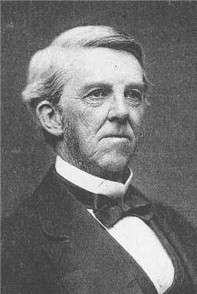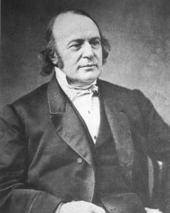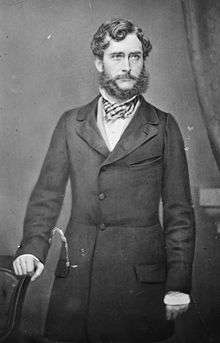Saturday Club (Boston, Massachusetts)
_(14576879648).jpg)
The Saturday Club, established in 1855, was an informal monthly gathering in Boston, Massachusetts, of writers, scientists, philosophers, historians and others.
Overview
The club began meeting informally at the Albion House in Boston.[1] Publishing agent and lawyer Horatio Woodman first suggested the gatherings among his friends for food and conversation.[2] By 1856, the organization became more structured with a loose set of rules, with monthly meetings held over dinner at the Parker House.[1] The Parker House served as their place of meeting for many years. It was a hotel built in 1854 by Harvey D. Parker.[3][4]
The gatherings led to the creation of the Atlantic Monthly, to which many of the members contributed.[2] The name was suggested by early member Oliver Wendell Holmes Sr.[5]
The original members of the group included Woodman, Louis Agassiz, Richard Henry Dana Jr., and James Russell Lowell.[2] In the following years, membership was extended to Holmes, Cornelius Conway Felton, Henry Wadsworth Longfellow, and William Hickling Prescott.[6] Other members included Ralph Waldo Emerson, Asa Gray, John Lothrop Motley, Benjamin Peirce, Charles Sumner, and others. Invitations to the group were considered a sort of affirmation of acceptance into Boston's high society. Ohio-native William Dean Howells was invited by James Russell Lowell in 1860 and recalled in a memoir that it seemed like a rite of passage. Holmes joked that Howells's presence serve as "something like the apostolic succession... the laying on of hands". A few years later, Howells was named editor of the Atlantic Monthly, which published many of the works by members of the group.[7]
In 1884, Oliver Wendell Holmes published a poem titled "At the Saturday Club" in which he reminisced about the gatherings. By then, many of its members were dead. Ralph Waldo Emerson's son, Edward Waldo Emerson, published two books about the Saturday Club and its members in the early 20th century. A version of the Saturday Club still exists in Boston.
Gallery
-

Oliver Wendell Holmes
-

Louis Agassiz
-

Benjamin Peirce
-

Charles Sumner and Henry Wadsworth Longfellow, 1863
-
Parker's, School Street, Boston, 1855
-

Ralph Waldo Emerson, ca.1872
-

Asa Gray
-

John Lothrop Motley, ca.1860
Further reading
- Adams, Thomas Boylston. Saturday Club 1957–1986. Boston: Saturday Club, 1988.
- Emerson, Edward Waldo. Early years of the Saturday Club, 1855–1870. Boston: Houghton Mifflin, 1918.
- Emerson, Edward Waldo. Later years of the Saturday Club, 1870–1920. Boston: Houghton Mifflin, 1927.
- Forbes, Edward Waldo. Saturday Club: A Century Completed, 1920–1956. Boston: Houghton Mifflin, 1958.
- Holmes, Oliver Wendell. "At the Saturday Club". 1884.
References
- 1 2 Mellow, James R. Nathaniel Hawthorne in His Times. Baltimore: The Johns Hopkins University Press, 1980: 539. ISBN 0-8018-5900-X
- 1 2 3 Gale, Robert L. A Henry Wadsworth Longfellow Companion. Westport, CT: Greenwood Press, 2003: 210. ISBN 0-313-32350-X
- ↑ Whitehill, Walter Muir. "Review of The Saturday Club: A Century Completed 1920-1956" by Edward W. Forbes and John H. Finley, Jr. The New England Quarterly, Vol. 32, No. 1 (Mar., 1959), pp. 108-112.
- ↑ Morison, Samuel Eliot. "Review of Later Years of the Saturday Club" by M. A. DeWolfe Howe. The New England Quarterly, Vol. 1, No. 2 (Apr., 1928), p. 267.
- ↑ Broaddus, Dorothy C. Genteel Rhetoric: Writing High Culture in Nineteenth-Century Boston. Columbia, South Carolina: University of South Carolina, 1999: 46.ISBN 1-57003-244-0.
- ↑ Gale, Robert L. A Henry Wadsworth Longfellow Companion. Westport, CT: Greenwood Press, 2003: 210–211. ISBN 0-313-32350-X
- ↑ O'Connell, Shaun. Boston: Voices and Visions. Amherst, MA: University of Massachusetts Press, 2010: 92. ISBN 978-1-55849-820-4
External links
- Guide to the Saturday Club Records, Massachusetts Historical Society
- Omni Parker House Boston at "Historic Hotels of America", National Trust for Historic Preservation